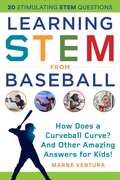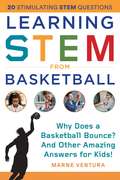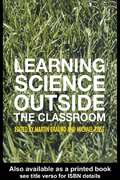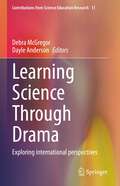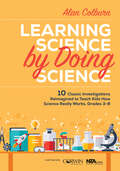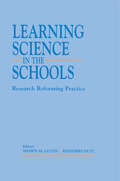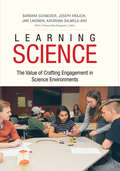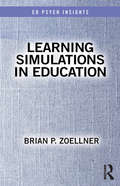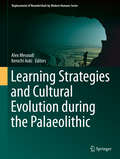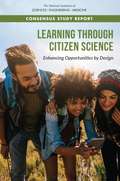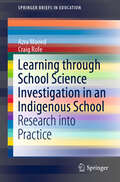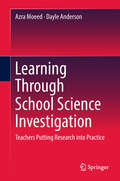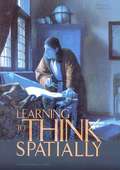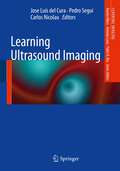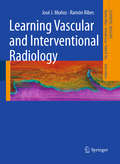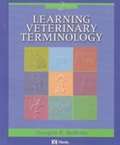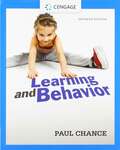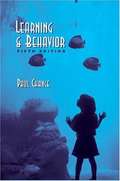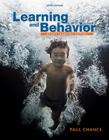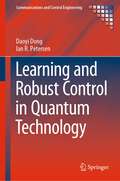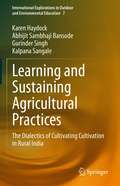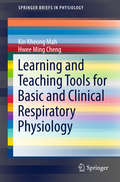- Table View
- List View
Learning STEM from Baseball: How Does a Curveball Curve? And Other Amazing Answers for Kids! (STEM Sports)
by Marne VenturaGet your sports-loving kid excited about Science, Technology, Engineering, and Math By integrating the thrill of learning into the context of baseball, Learning STEM from Baseball presents a whole new ball game. Unleash the inner scientist, engineer, and mathematician in your child as they learn that sports and STEM aren't so separate after all. You'll both love finding out the answers to questions such as: What's a sweet spot?When was the pitching machine invented?How are baseballs made?How do numbers help baseball players? What are some STEM careers in baseball?And so much more! This easy-to-follow introduction to STEM topics sets kids up to make connections across subjects, discover new facts about baseball, and grow curious about academic fields!
Learning STEM from Basketball: Why Does a Basketball Bounce? And Other Amazing Answers for Kids! (STEM Sports)
by Marne VenturaGet your sports-loving kid excited about Science, Technology, Engineering, and Math By integrating the thrill of learning into the context of basketball, Learning STEM from Basketball presents an educational slam dunk. Unleash the inner scientist, engineer, and mathematician in your child as they learn that sports and STEM aren't so separate after all. You'll both love finding out the answers to questions such as: Why does a basketball bounce?What's a shot clock?Why does a basketball rim have a net?What's the math behind a free throw?And so much more! This easy-to-follow introduction to STEM topics sets kids up to make connections across subjects, discover new facts about basketball, and grow curious about academic fields!
Learning Science Outside the Classroom
by Martin Braund and Michael ReissThis book shows how a wide range of contexts for learning science can be used outside of the classroom, and includes learning: at museums, science centres and planetaria from newspapers, magazines and through ICT at industrial sites and through science trails at zoos, farms, botanic gardens, residential centres and freshwater habitats in school grounds. With contributions from well known and respected practitioners in all fields of science education and through using case studies, Learning Science Outside the Classroom offers practical guidance for teachers, assistant teaching staff and student teachers involved in primary and secondary education. It will help enable them to widen the scientific experience and understanding of pupils. The advice in this book has been checked for safety by CLEAPSS.
Learning Science Through Drama: Exploring international perspectives (Contributions from Science Education Research #11)
by Dayle Anderson Debra McGregorThis book presents a wide range of international perspectives that explore the different ways the diverse forms of drama supports learning in science. It illustrates how learning science by adopting and adapting theatrical techniques can offer more inclusive ways for students to relate to scientific ideas and concepts. The theatrical processes by which subject matter can be introduced, thought about, discussed, transformed, enacted and disseminated are shown to be endless. The first section of the book considers different ways of theorising and applying drama in classrooms. The second section provides a range of case studies illustrating how role play, performance, embodiment and enquiry approaches can be utilised for learning in primary, secondary and tertiary education contexts. The third section demonstrates how different research methods from questionnaires, particular kinds of tests and even the theatrical conventions themselves can provide rich data that informs how drama impacts on learning science.
Learning Science by Doing Science: 10 Classic Investigations Reimagined to Teach Kids How Science Really Works, Grades 3-8
by Alan ColburnTime-tested activities to teach the key ideas of science—and turn students into scientists! This witty book adapts classic investigations to help students in grades 3 through 8 truly think and act like scientists. Chapter by chapter, this accessible primer illustrates a “big idea” about the nature of science and offers clear links to the Next Generation Science Standards and its Science and Engineering Practices. You’ll also find: A reader-friendly overview of the NGSS Guidance on adapting the activities to your grade level, including communicating instructions, facilitating discussions, and managing safety concerns Case studies of working scientists to highlight specifics about the science and engineering practices
Learning Science by Doing Science: 10 Classic Investigations Reimagined to Teach Kids How Science Really Works, Grades 3-8
by Alan ColburnTime-tested activities to teach the key ideas of science—and turn students into scientists! This witty book adapts classic investigations to help students in grades 3 through 8 truly think and act like scientists. Chapter by chapter, this accessible primer illustrates a “big idea” about the nature of science and offers clear links to the Next Generation Science Standards and its Science and Engineering Practices. You’ll also find: A reader-friendly overview of the NGSS Guidance on adapting the activities to your grade level, including communicating instructions, facilitating discussions, and managing safety concerns Case studies of working scientists to highlight specifics about the science and engineering practices
Learning Science in the Schools: Research Reforming Practice
by Reinders Duit Shawn M. GlynnScience -- and the technology derived from it -- is having a dramatic impact on the quality of our personal lives and the environment around us. Science will have an even greater impact on the lives of our students. The lives of scientifically literate students will be enriched by their understanding, appreciation, and enjoyment of the natural world. To prosper in the near future, all students must become scientifically literate and embrace the notion of life-long learning in science. Without scientific literacy, it will become impossible for students to make informed decisions about the interrelated educational, scientific, and social issues that will confront them in the future. Intended for science teachers, teacher educators, researchers, and administrators, this volume is concerned with the innovative research that is reforming how science is learned in schools. The chapters provide overviews of current research and illustrate how the findings of this research are being applied in schools. This research-based knowledge is essential for effective science instruction. The contributors are leading authorities in science education and their chapters draw clear connections among research, theory, and classroom practice. They provide excellent examples from science classes in which their research has reformed practice. This book will help educators develop the scientific literacy of students. It bridges the gap between cutting-edge research and classroom practice to provide educators with the knowledge they need to foster students' scientific literacy.
Learning Science: The Value of Crafting Engagement in Science Environments
by Barbara Schneider Joseph Krajcik Jari LavonenAn innovative, internationally developed system to help advance science learning and instruction for high school students This book tells the story of a $3.6 million research project funded by the National Science Foundation aimed at increasing scientific literacy and addressing global concerns of declining science engagement. Studying dozens of classrooms across the United States and Finland, this international team combines large-scale studies with intensive interviews from teachers and students to examine how to transform science education. Written for teachers, parents, policymakers, and researchers, this book offers solutions for matching science learning and instruction with newly recommended twenty-first-century standards.
Learning Simulations in Education (Ed Psych Insights)
by Brian P. ZoellnerTechnology-enabled simulations are increasingly used for students in K-12 education and have the potential to improve teaching and learning across domains. Across five chapters, this book explores the psychological foundation of simulation use in instruction, guiding readers through individual differences among learners and contexts while addressing theory, pedagogy, cognitive processes, and more. This concise volume is designed for any education course that includes simulations in the curriculum and will be indispensable for student researchers and both pre- and in-service teachers alike.
Learning Strategies and Cultural Evolution during the Palaeolithic
by Alex Mesoudi Kenichi AokiThis volume is motivated by the desire to explain why Neanderthals were replaced by modern humans, in terms of cultural differences between the two (sub-) species. It provides up-to-date coverage on the theory of cultural evolution as is being used by anthropologists, archaeologists, biologists and psychologists to decipher hominin cultural change and diversity during the Palaeolithic. The contributing authors are directly involved in this effort and the material presented includes novel approaches and findings. Chapters explain how learning strategies in combination with social and demographic factors (e. g. , population size and mobility patterns) predict cultural evolution in a world without the printing press, television or the Internet. Also addressed is the inverse problem of how learning strategies may be inferred from actual trajectories of cultural change, for example as seen in the North American Palaeolithic. Mathematics and statistics, a sometimes necessary part of theory, are explained in elementary terms where they appear, with details relegated to appendices. Full citations of the relevant literature will help the reader to further pursue any topic of interest.
Learning Through Citizen Science: Enhancing Opportunities By Design
by Engineering Medicine National Academies of SciencesIn the last twenty years, citizen science has blossomed as a way to engage a broad range of individuals in doing science. Citizen science projects focus on, but are not limited to, nonscientists participating in the processes of scientific research, with the intended goal of advancing and using scientific knowledge. A rich range of projects extend this focus in myriad directions, and the boundaries of citizen science as a field are not clearly delineated. Citizen science involves a growing community of professional practitioners, participants, and stakeholders, and a thriving collection of projects. While citizen science is often recognized for its potential to engage the public in science, it is also uniquely positioned to support and extend participants’ learning in science. Contemporary understandings of science learning continue to advance. Indeed, modern theories of learning recognize that science learning is complex and multifaceted. Learning is affected by factors that are individual, social, cultural, and institutional, and learning occurs in virtually any context and at every age. Current understandings of science learning also suggest that science learning extends well beyond content knowledge in a domain to include understanding of the nature and methods of science. Learning Through Citizen Science: Enhancing Opportunities by Design discusses the potential of citizen science to support science learning and identifies promising practices and programs that exemplify the promising practices. This report also lays out a research agenda that can fill gaps in the current understanding of how citizen science can support science learning and enhance science education.
Learning Through School Science Investigation in an Indigenous School: Research into Practice (SpringerBriefs in Education)
by Azra Moeed Craig RofeThis book presents the findings of a case study conducted in a Māori medium school where a space was created for Pūtaiao (Western science) teaching and learning from year 1 to 13. Science is currently taught in Te Reo Māori in primary school and in English in secondary school, and evidence suggests that students are engaging in science education, learning to investigate, and achieving in science. In New Zealand, most students attend English medium state schools; however, approximately 15% of indegenous students attend Māori medium schools. These schools are underpinned with Kura Kaupapa Māori philosophy, which is culturally specific to Māori and aims to revitalise the Māori language, and Māori knowledge and culture. Māori students’ engagement and achievement continues to be a challenge for both mainstream and Māori medium schools, teachers and students due to lack of access to science teachers who can teach in Te Reo Māori. School leaders and whanau (families) believed that by year 9 (age 13) their students had developed their identity as Māori, and were proficient in Te Reo Māori. They wanted their students to have the option to learn science, experience success and have the choice to conitnue in science, so they made the difficult decision for science to be taught in English in secondary school. The book discusses how teachers in indigenous schools, who have extensive knowledge of culture and context specific pedagogies, can gain confidence to teach science through collaboration with and support from researchers with whom they have developed strong professional relationships.
Learning Through School Science Investigation: Teachers Putting Research Into Practice (SpringerBriefs in Education)
by Azra Moeed Dayle AndersonThis book explores teaching and learning through science investigation and practical work. It draws upon two representative case studies from New Zealand and examines what students are learning from science investigation; in addition, it identifies and describes ways in which teachers can make changes that benefit student learning when given time to reflect and respond to research literature and findings. The book illustrates how teaching through science investigations in ways that are informed by research can lead to positive learning outcomes for students. As such, it offers valuable insights for practitioners, researchers, and educators with an interest in learning through science investigation.
Learning To Think Spatially
by National Research Council of the National AcademiesSpatial thinking—a constructive combination of concepts of space, tools of representation, and processes of reasoning—uses space to structure problems, find answers, and express solutions. It is powerful and pervasive in science, the workplace, and everyday life. By visualizing relationships within spatial structures, we can perceive, remember, and analyze the static and dynamic properties of objects and the relationships between objects. Despite its crucial role underpinning the National Standards for Science and Mathematics, spatial thinking is currently not systematically incorporated into the K-12 curriculum. Learning to Think Spatially: GIS as a Support System in the K-12 Curriculum examines how spatial thinking might be incorporated into existing standards-based instruction across the school curriculum. Spatial thinking must be recognized as a fundamental part of K-12 education and as an integrator and a facilitator for problem solving across the curriculum. With advances in computing technologies and the increasing availability of geospatial data, spatial thinking will play a significant role in the information- based economy of the 21st-century. Using appropriately designed support systems tailored to the K-12 context, spatial thinking can be taught formally to all students. A geographic information system (GIS) offers one example of a high-technology support system that can enable students and teachers to practice and apply spatial thinking in many areas of the curriculum.
Learning Ultrasound Imaging
by Carlos Nicolau Jose Luís del Cura Pedro SeguíThis book offers a practical approach to the world of diagnostic ultrasound. It has been structured in a reader-friendly, case-based format that makes it easy and enjoyable to learn the basics of the applications and interpretation of ultrasound. Each case includes illustrations, descriptions of the imaging findings, and technical details and serves to identify the essential imaging features of the pathology under consideration, thus assisting the reader in the diagnosis of similar cases. The book is divided into 17 short chapters that review the most important areas of ultrasound application and also document the latest advances in the use of contrast and interventional ultrasound. The authors treat every topic from a "how to do it" perspective with the aim of imparting their wide experience in use of the technique. This book forms part of the Learning Imaging series for medical students, residents, less experienced radiologists, and other medical staff.
Learning Vascular and Interventional Radiology
by Ramón Ribes José J. MuñozThis book is an introduction to interventional radiology. Written in a case-based format, the book is subdivided into ten chapters made up of ten vascular and non-vascular interventional radiology cases.Each case contains illustrations and legends describing the imaging findings and technical details of each intervention, comments from anatomical, physiopathological and radiological standpoints, as well as a description of the interventional procedure and the required interventional devices.The book is aimed at vascular and non-vascular interventional radiologists, vascular surgeons, radiology residents, vascular surgery residents, nurses and radiology technicians.
Learning Veterinary Terminology (Second Edition)
by Douglas F. McbrideThis text is newly updated to reflect the latest terminology and features numerous new and revised pedagogical features that make it an excellent resource both in the classroom and for self-study. Brand-new additions include several new appendices, new anatomical drawings, and a more extensive index. Many sections have been completely rewritten for consistency and greater reader comprehension, and review sections now include more thought-provoking questions and multiple-choice tests.
Learning and Behavior
by Paul ChanceLEARNING AND BEHAVIOR, Seventh Edition, is stimulating and filled with high-interest queries and examples. Based on the theme that learning is a biological mechanism that aids survival, this book embraces a scientific approach to behavior but is written in clear, engaging, and easy-to-understand language. Available with InfoTrac® Student Collections http://gocengage.com/infotrac.
Learning and Behavior (5th edition)
by Paul ChancePer the author: The theme of this edition is that learning is a biological mechanism that aids survival. My goal was to write a text that would cover the course contents in the theory and research of behavior and learning. This book is an instructional tool, not a reference book.
Learning and Behavior: Active Learning Edition (6th edition)
by Paul ChanceThis undergraduate textbook introduces the natural science approach to behavior and describes the efforts of researchers to understand the kinds of experiences that produce learning, the circumstances under which learning in one situation carries over to another situation, the effects of different reinforcement schedules, the durability of learned behavior, and the limitations of learning.
Learning and Memory: From Brain to Behavior (Second Edition)
by Mark A. Gluck Eduardo Mercado Catherine E. MyersDevelopments in neuroscience have changed the field of learning and memory significantly in the last ten years. This comprehensive introduction to learning and memory covers behavioural processes, brain systems, and clinical perspectives.
Learning and Robust Control in Quantum Technology (Communications and Control Engineering)
by Ian R. Petersen Daoyi DongThis monograph provides a state-of-the-art treatment of learning and robust control in quantum technology. It presents a systematic investigation of control design and algorithm realisation for several classes of quantum systems using control-theoretic tools and machine-learning methods. The approaches rely heavily on examples and the authors cover:sliding mode control of quantum systems;control and classification of inhomogeneous quantum ensembles using sampling-based learning control;robust and optimal control design using machine-learning methods;robust stability of quantum systems; and H∞ and fault-tolerant control of quantum systems. Both theoretical algorithm design and potential practical applications are considered. Methods for enhancing robustness of performance are developed in the context of quantum state preparation, quantum gate construction, and ultrafast control of molecules.Researchers and graduates studying systems and control theory, quantum control, and quantum engineering, especially from backgrounds in electrical engineering, applied mathematics and quantum information will find Learning and Robust Control in Quantum Technology to be a valuable reference for the investigation of learning and robust control of quantum systems. The material contained in this book will also interest chemists and physicists working on chemical physics, quantum optics, and quantum information technology.
Learning and Sustaining Agricultural Practices: The Dialectics of Cultivating Cultivation in Rural India (International Explorations in Outdoor and Environmental Education #7)
by Gurinder Singh Karen Haydock Abhijit Sambhaji Bansode Kalpana SangaleThis book describes a participatory case study of a small family farm in Maharashtra, India. It is a dialectical study of cultivating cultivation: how paddy cultivation is learnt and taught, and why it is the way it is. The paddy cultivation that the family is doing at first appears to be ‘traditional’. But by observation and working along with the family, the authors have found that they are engaging in a dynamic process in which they are questioning, investigating, and learning by doing. The authors compare this to the process of doing science, and to the sort of learning that occurs in formal education. The book presents evidence that paddy cultivation has always been varying and evolving through chance and necessity, experimentation, and economic contingencies. Through the example of one farm, the book provides a critique of current attempts to sustain agriculture, and an understanding of the ongoing agricultural crisis.
Learning and Teaching Primary Science
by Angela FitzgeraldLearning and Teaching Primary Science brings primary science to life through the stories and experiences of pre-service and practising teachers. It explores the roles of the teacher and the learner of science and examines major issues and challenges, including: engaging diverse learners, utilising technology, assessment and reporting, language and representation, and integration in the 'crowded curriculum'. Each chapter contains examples, activities and reflective questions to help readers create relevant and meaningful lesson plans. Dedicated chapters for the areas of chemistry, physics, biology and earth and environmental science will give confidence to those without a science background. Practical strategies and skills are underpinned by relevant theories and evidence-based research. Written by experts from Australia and New Zealand, Learning and Teaching Primary Science is an essential resource for those beginning their journey of teaching science in the primary school classroom.
Learning and Teaching Tools for Basic and Clinical Respiratory Physiology
by Kin Kheong Mah Hwee Ming ChengThis volume synthesizes pathways in respiratory mechanics and the dynamics of air-blood and blood-cellular gas exchange for students and teachers in respiratory physiology. The authors strive to make physiology fun to learn. This aspect of knowledge acquisition is reflected in the way topics are approached, for example by using playing cards in what is coined 'Respi-CARDology'. The first section of this book reviews the framework and foundations of basic respiratory physiology. Since this book was not written to be a comprehensive physiology text, the authors have focused on leading students to appreciate and understand integrative principles and homeostatic mechanisms in lung function. The second section of this book mainly deals with the clinical application of fundamental knowledge of respiratory physiology.
